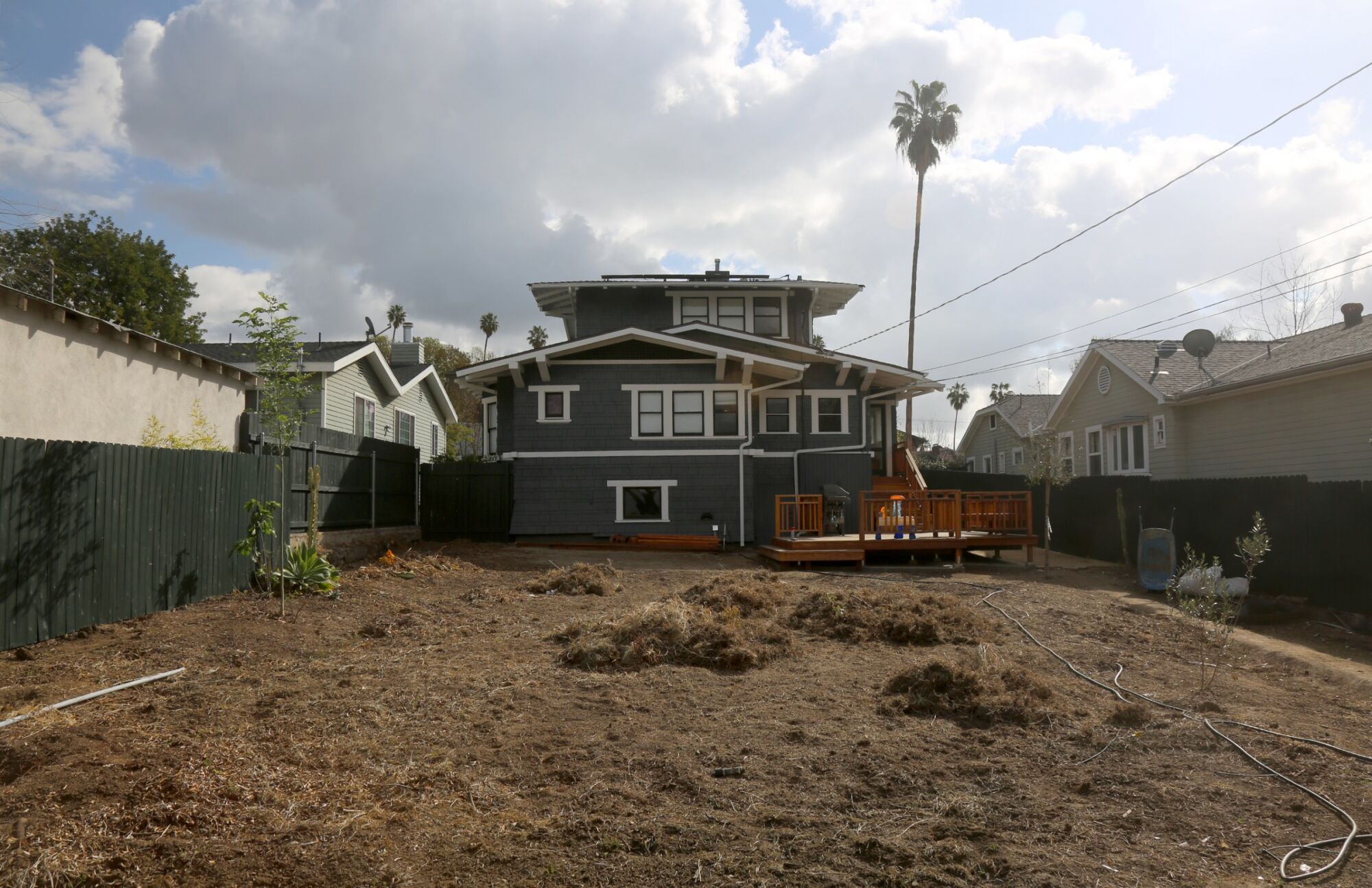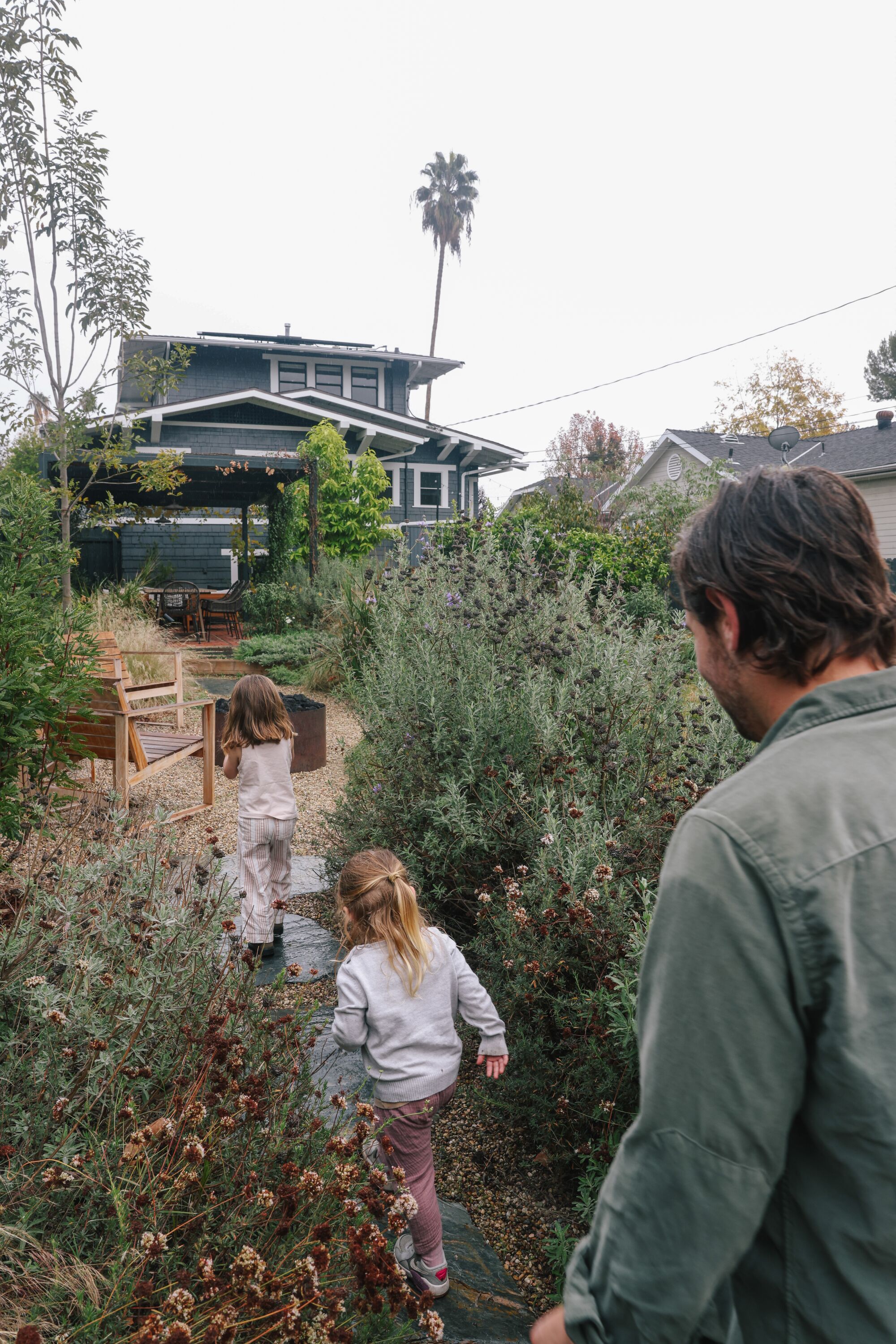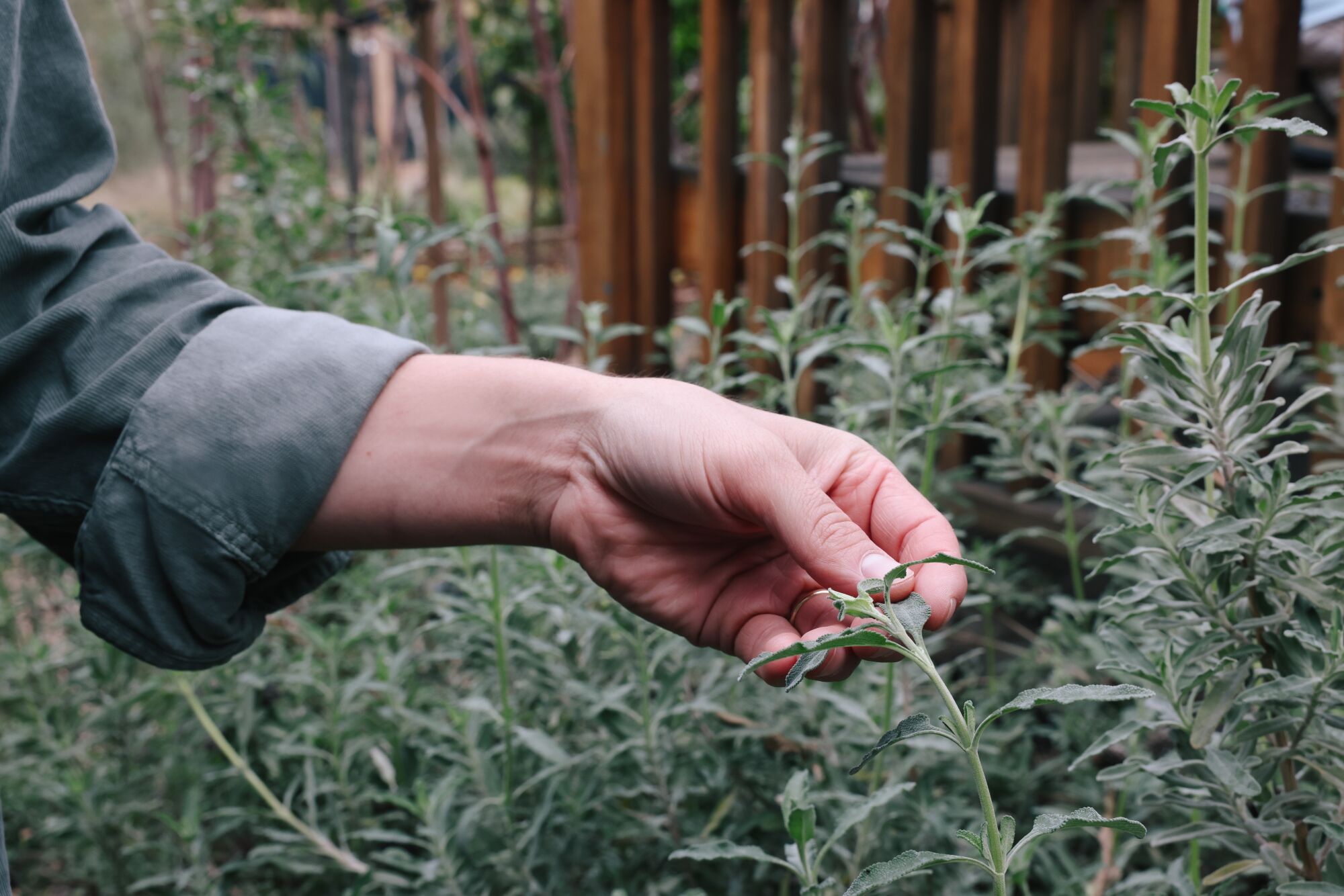Water-hungry lawns are symbols of Los Angeles’ past. In this series, we spotlight yards with alternative, low-water landscaping built for the future.
As 5-year-old Stella Penn and her sister, Maxine, 3, enthusiastically play hide-and-seek in the backyard of their Eagle Rock home, the girls are accompanied by a merry band of lizards, butterflies and birds drawn to the yard’s low-water California natives, abundant fruit trees and the fragrance of Cleveland sage and Champaca trees.
Oblivious to the rainfall on an overcast morning in Los Angeles, the sisters move to a chunky wood stump in the front yard where, unprovoked, they assemble a “pizza” with a large sycamore leaf and locally sourced bits of gravel, California buckwheat and blue bush acacia as toppings.

Sisters Stella, left, and Maxine Penn assemble “pizza” under a Western sycamore tree, left, and a blue bush acacia, right, in their front yard.
(Dania Maxwell / Los Angeles Times)

(Dania Maxwell / Los Angeles Times)
This is exactly what their parents, Kyle and Claire Penn, both 38, had hoped for when they asked landscape designer Lauren Hamer of Los Angeles-based Terremoto to help them create a wild and carefree, bee-buzzing, kid-friendly landscape.
“We wanted a space that felt organic, lush and voluminous,” says Kyle, a product and interaction designer at Google. “It was important to us to create something that would respect the natural environment and be a haven for birds and bugs and bees. We also wanted the garden to be a genuinely comfortable place for our family to spend time in.”
When the first-time homeowners bought the four-bedroom 1915 Craftsman home in 2018, the backyard was an enormous, shapeless dead zone with a few random cactuses, a lonely olive shrub, an oak tree and an elm tree sapling.

Rethinking the enormous and bare backyard was overwhelming for the busy couple, who were sheltering in place at home with two young children early in the COVID-19 pandemic.
(Terremoto)

The Penn family walks through fragrant Cleveland sage and California buckwheat in their Eagle Rock backyard.
(Dania Maxwell / Los Angeles Times)
Soon after the two bought the property, Claire’s father came and laid sod in the backyard so that his granddaughters would have a place to run around. Although his heart was in the right place, the couple felt that it was “ridiculous” to try to keep the lawn alive in the face of California’s ongoing drought and eventual water restrictions. “It sucked up so much water,” Kyle says. “We had the lawn for a season and gave up. Obviously, we need to be using less water. It made sense to remove it.”
After leaving the lawn to die, the Penns were overwhelmed by what to do with their sizable backyard (in total the lot measures 8,700 square feet). So in 2021, after sheltering in place during the coronavirus pandemic, they decided to invest in an outdoor habitat where they could experience nature in a variety of ways as a family. “But we needed design help,” Kyle says.

Claire Penn lifts daughter Maxine, 3, while her other daughter, Stella, 5, enjoys the play area at the back of the property.
(Dania Maxwell / Los Angeles Times)
For her part, Hamer designed the garden in an overwhelmingly golden-green palette. “If you’re going to work with people who want to go low-water and plant natives, the color selection is going to be more golden,” Hamer says. “During some parts of the year, it’s going to be brown. That’s just part of the seasons in California. Half of October it will be brown, and people have to embrace that.” Another thing to accept when gardening with mostly natives? “The garden is going to be wild,” she says.
Over eight weeks, Hamer divided the gently sloping backyard into three slight terraces and planted it with mostly California native plants that give the shapeless lot variety and differentiation.
On the first terrace, a pergola-covered outdoor dining room and living room serves as a shady place to congregate on hot days and during family movie nights. Next to it, a tight circle of fruit trees — kumquat, lime, grapefruit, orange, Meyer lemon, apricot and pear — which are watered with greywater from the home’s washing machine, offer further shade and places to explore.

There is a fluidity between work and play in the backyard. Kyle works in the accessory dwelling unit, or ADU, on the property.
(Dania Maxwell / Los Angeles Times)
The second terrace is highlighted by a small meadow planted with Berkeley sedge (Carex divulsa), a low-water bunching grass that resembles turf, along with raised vegetable beds where the family harvests their own food.
The third level at the back of the property is designated for play, with a simple playhouse, swings and sandbox.
In front, Hamer installed seven fairly large sycamore trees that will eventually provide shade and cool the house during hot Los Angeles summers.

The family stands inside a citrus grove that is watered with greywater from their washing machine.
(Dania Maxwell / Los Angeles Times)
Although the garden includes many drought-tolerant plants that can endure the heat with little watering, Hamer notes that it is not exclusively a “native garden” but a climate-appropriate garden for Los Angeles. “It includes some plants that are well suited to Los Angeles, such as a Champaca tree that is soaking up some greywater, and Atlas fescue, which is a beautiful ornamental grass,” she says. “The key is that they are climate-adapted. They play well with the natives and they have something to add — in this case, a pop of neon green and loads of perfumed flowers.”
Stepping into the garden now, it’s hard to believe it was ever a barren landscape. The garden is playful, lush, dramatic and unexpected. There are native bush anemone (Carpenteria californica); tall Matilija poppies that look like big fried eggs in the spring; toyon (Heteromeles arbutifolia) and flowering Palmer’s Indian mallow (Abutilon palmeri). On the pergola, native morning glory and California honeysuckle have taken off on aircraft wire while blue dune lyme grass (Elymus arenarius) and Terra Seca sage (Salvia mellifera ‘Terra Seca’) frame the girls’ sandbox at the back of the yard.

Stella Penn enjoys the rain as she cooks at her outdoor kitchen with a Matilija poppy, center back, and Palmer’s Indian mallow plant growing, right, in her backyard.
(Dania Maxwell / Los Angeles Times)
When it comes to watering, Kyle says his family waters the meadow on a drip twice a week and the landscape once every 10 days. “It’s low-water but lush,” Kyle says. “It doesn’t feel low-water when you’re in it.” The couple also credits the garden’s flourishing state to monthly maintenance from landcare specialists from Saturate who are trained in tending primarily California native gardens.
Since planting their garden in spring 2021, the Penn family has watched it take off. “I’ve never seen a garden explode like this,” Hamer says. “That was wild because it takes a while for birds and pollinators to find your garden. But within six to eight months they arrived.”
The front- and backyard renovations cost roughly $100,000, including design fees, labor, drip system, plant materials, play structures, pergola and patio, lighting, a firepit and a gas line. The busy couple says it was all worth it.

A Palmer’s Indian mallow (Abutilon palmeri).
(Dania Maxwell / Los Angeles Times)

Blue dune lyme grass (Elymus arenarius), top, and Terra Seca sage (Salvia mellifera ‘Terra Seca’), bottom, grow near the sandbox.
(Dania Maxwell / Los Angeles Times)
At no point — even during one of California’s wettest months in recent history — have the Penns questioned their decision to remove the lawn. “It has been such a rich experience,” says Claire, who is a psychotherapist. “We spend so much time outside. I love having different zones for different experiences and having an opportunity to teach the girls how to harvest their own food.”
As Southern California grapples with climate change, water shortages and the Colorado River in crisis, the Penns’ garden illustrates how climate-appropriate plants can be just as stimulating for children as thirsty turf. “The girls love to play catch and hide-and-seek in the garden and are often out there with their bug catchers,” says Kyle, smiling. “We haven’t given up anything by not being able to run around on grass.”
The Los Angeles Department of Water and Power is hosting several hands-on “Lawn Be Gone” workshops through April where you can learn how to remove your turf and replace it with low-water California-friendly and native plants: lawnbegone.ladwp.com.

Kyle Penn touches a Cleveland sage (Salvia clevelandii) in the backyard of his Eagle Rock home.
(Dania Maxwell / Los Angeles Times)
Landscape designer Lauren Hamer shares several of her favorite key species from the garden.
California buckwheat, Eriogonum fasciculatum: “We all love it!”
Mexican elderberry, Sambucus mexicana: “A real ‘feed me’ guy who is there to soak up any extra greywater and sits between the dryer natives and the fruit trees.”
Cleveland sage, Salvia clevelandii: “It doesn’t get more bulletproof than this on a sunny Los Angeles site.”

Cleveland sage.
(Dania Maxwell / Los Angeles Times)
Bush anemone, Carpenteria californica: “A beautiful although sometimes temperamental white flowering floppy shrub.”
Coast morning glory, Calystegia macrostegia: “Growing all over the pergola.”
Giant wildrye grass, Leymus condensatus: “A big grass that I prefer over the more commonly used ‘Canyon Prince’ variety, which is very blue-green.”
California narrow leaf milkweed, Asclepias fascicularis: “Otherwise known as the correct milkweed to plant!”

A blue bush acacia.
(Dania Maxwell / Los Angeles Times)

Plants including foxtail agave, Cleveland sage, common yarrow, California buckwheat and bush monkey flower grow alongside a path.
(Dania Maxwell / Los Angeles Times)
Stay connected with us on social media platform for instant update click here to join our Twitter, & Facebook
We are now on Telegram. Click here to join our channel (@TechiUpdate) and stay updated with the latest Technology headlines.
For all the latest Art-Culture News Click Here
